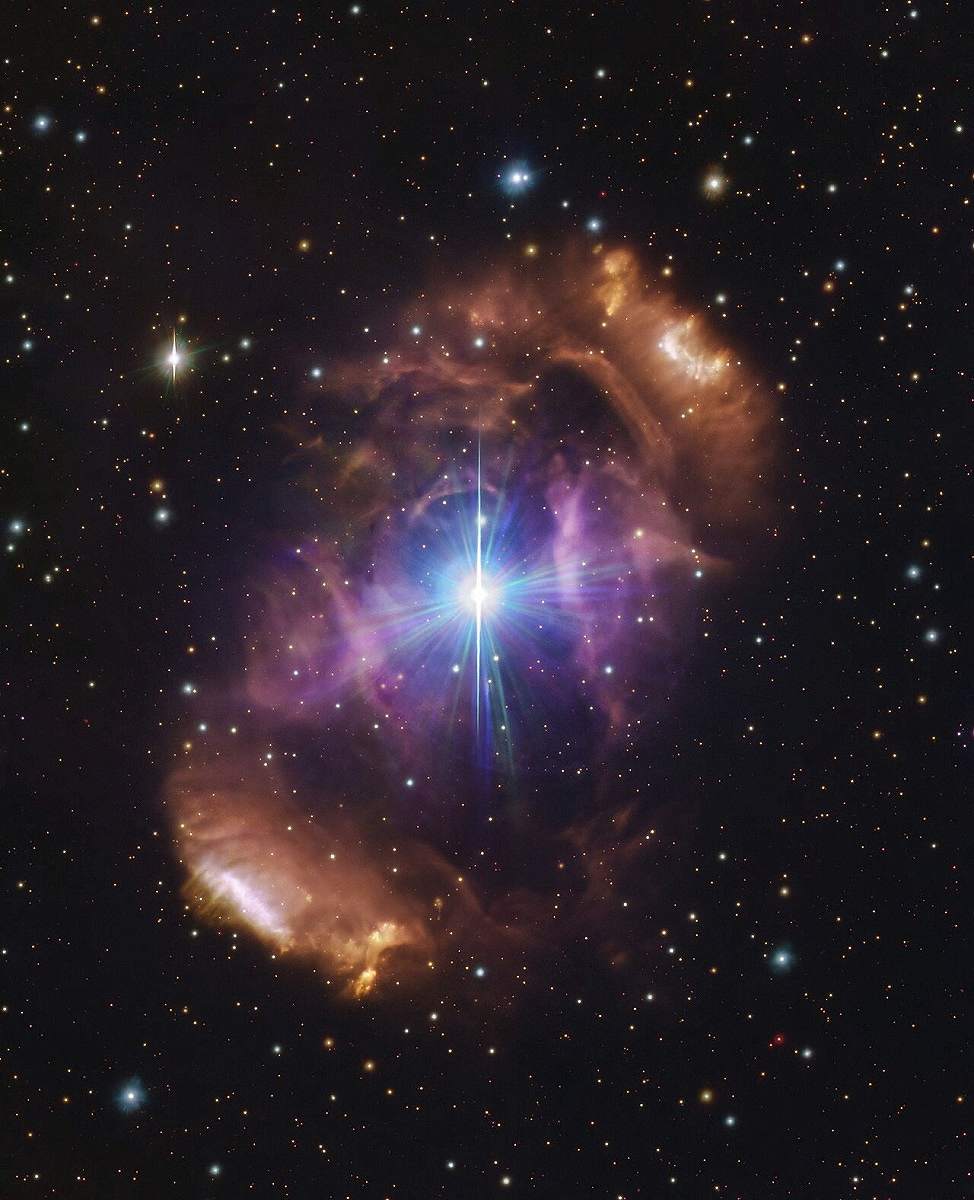
The nebula NGC 6164/6165, also known as the Dragon’s Egg, a cloud of gas and dust surrounding a pair of stars called HD 148937, is seen in this undated image taken with the VLT Survey Telescope hosted at the European Southern Observatory’s Paranal Observatory in Cerro Paranal, Chile.
12:33 JST, April 18, 2024
WASHINGTON (Reuters) — Two large stars residing inside a spectacular cloud of gas and dust nicknamed the “Dragon’s Egg” nebula have presented a puzzle to astronomers. One of them has a magnetic field, as does our sun. Its companion does not. And such massive stars are not usually associated with nebulae.
Researchers now appear to have resolved this mystery while also explaining how the relatively few massive stars that are magnetic got that way. Blame it on stellar fratricide, they said. In this case, the bigger star apparently gobbled up a smaller sibling star, and the mixing of their stellar material during this hostile takeover created a magnetic field.
“This merger was likely very violent. When two stars merge, material can be thrown out, and this likely created the nebula we see today,” said Chile-based European Southern Observatory astronomer Abigail Frost, lead author of the study published on April 11 in the journal Science.
Computer simulations previously had predicted that the blending of stellar material during such a merger could create a magnetic field in the combined star born in this process.
“Our study is the observational smoking gun confirming this scenario,” said astronomer Hugues Sana of KU Leuven in Belgium, the study’s senior author.
These two stars — gravitationally bound to each other in what is called a binary system — are located in our Milky Way galaxy about 3,700 light-years from Earth in the constellation Norma. A light-year is the distance light travels in a year, 9.5 trillion kilometers.
The researchers used nine years of observations by the Chile-based Very Large Telescope.
The magnetic star is about 30 times more massive than the sun. Its remaining companion is about 26.5 times more massive than the sun. They orbit at a distance from each other varying from seven to 60 times the distance between Earth and the sun.
The Dragon’s Egg is so named because it is located relatively near a larger nebula complex called the Fighting Dragons of Ara. The stars inside the Dragon’s Egg appear to have started out 4 million-6 million years ago as a triple system — three stars born at the same time and gravitationally bound.
The triple system’s two innermost members included a larger star — perhaps 25 to 30 times the mass of the sun — and a smaller one — maybe five to 10 times the sun’s mass.
The more massive one evolved more quickly than the other, with its outer layer engulfing the smaller star and triggering a merger that ejected into space the gas and dust that make up the nebula, the researchers said.
This occurred very recently on a cosmic time scale — about 7,500 years ago, based on the expansion velocity of the material in the nebula. It consists of mostly hydrogen and helium, but also an unusually large amount of nitrogen, thanks to the merger.
Many sun-sized stars generate magnetic fields.
“For low-mass stars like our sun, convective heating — like the movement of hot water in a radiator in your home — creates a movement of stellar material. This in turn creates a dynamo effect which induces a magnetic field,” Frost said.
“However, for massive stars — greater than eight times the mass of our sun — different heating effects are in play, and so explaining the presence of magnetic fields for these types of stars is more tricky. This merger scenario ticks all the boxes,” Frost added.
About 7% of massive stars are known to have a magnetic field. The second star in this binary system, uninvolved in the violent merger, does not.
Stellar magnetic fields store immense amounts of energy. The sun’s magnetic storms can interact with Earth’s atmosphere and create our planet’s thrilling auroras, but also can disrupt radio signals and navigation systems.
An image of the nebula released with the study is visually striking.
“The richness of the physics and chemistry at play gave rise to a beautiful structure,” Sana said.
"Science & Nature" POPULAR ARTICLE
-

Genome Study Reveals Milestone in History of Cat Domestication
-

Big Leap in Quest to Get to Bottom of Climate Ice Mystery
-

Japan Set to Participate in EU’s R&D Framework, Aims to Boost Cooperation in Tech, Energy
-

Paws on Parade: Nairobi’s Dogs Dazzle at ‘Pawchella’
-

Japan’s H3 Rocket Failed in Latest Launch, Says Official
JN ACCESS RANKING
-

Tokyo Economic Security Forum to Hold Inaugural Meeting Amid Tense Global Environment
-

Keidanren Chairman Yoshinobu Tsutsui Visits Kashiwazaki-Kariwa Nuclear Power Plant; Inspects New Emergency Safety System
-

Imports of Rare Earths from China Facing Delays, May Be Caused by Deterioration of Japan-China Relations
-

University of Tokyo Professor Discusses Japanese Economic Security in Interview Ahead of Forum
-

Japan Pulls out of Vietnam Nuclear Project, Complicating Hanoi’s Power Plans






















